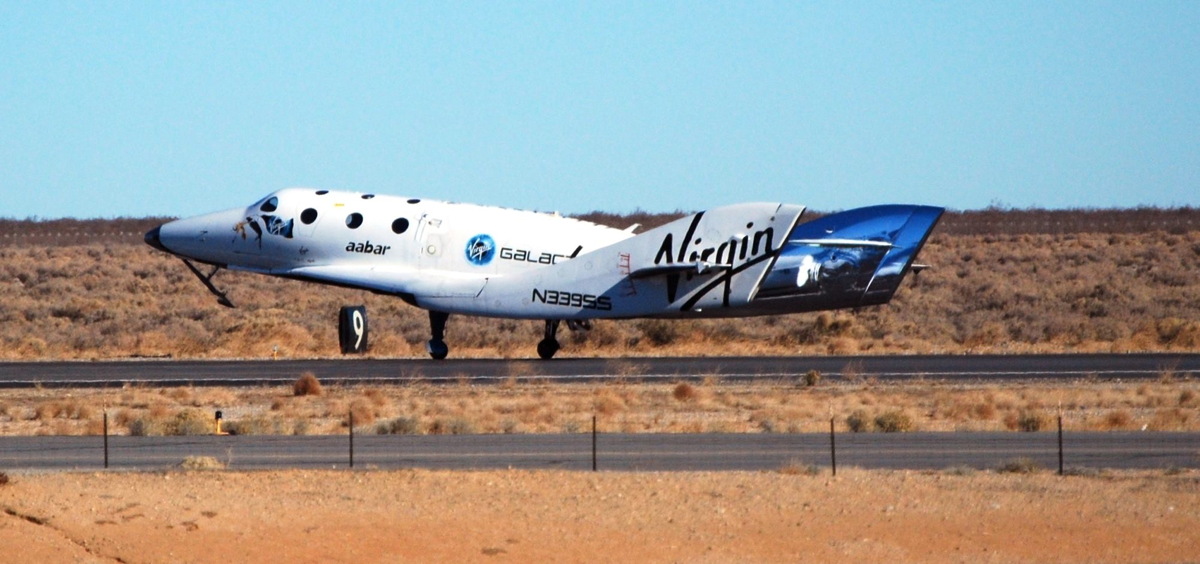Virgin Galactic's Private SpaceShipTwo Spacecraft Soars in Glide Test

MOJAVE, Calif. — Virgin Galactic's private SpaceShipTwo space plane, built to fly space tourists on suborbital thrill rides, successfully flew its latest glide test over the California desert today (Dec. 11).
The SpaceShipTwo spacecraft, dubbed the VSS Enterprise, performed the glide test with a glossy new coating on its twin aft-mounted tail booms. The flight test originated from the Mojave Air and Space Port in California's Mojave Desert.
"#SpaceShipTwo back on the ground after another important glide flight, which proceeded as planned," Virgin Galactic officials said in a Twitter post. "Our next powered flight is coming up soon." [See photos of SpaceShipTwo's supersonic rocket flight.]
Virgin Galactic was founded by British billionaire Sir Richard Branson with the goal of serving as the world's first private spaceliner service. The company's air-launched SpaceShipTwo is designed to fly six paying passengers and two pilots on rocket rides to suborbital space, and then return to Earth for a runway landing. The spacecraft is hauled into launch position by its huge carrier aircraft, the WhiteKnightTwo. Tickets for a seat cost about $250,000.
For today's test, SpaceShipTwo's in-board tail booms sported shiny new coatings of Kapton. The material, which is designed to allow SpaceShipTwo to better manage temperatures from its hybrid engine, made the ship much easier to see as it reflected the bright sunlight.
The glide flight test began today at 8:55 a.m. PST (1155 GMT) as the WhiteKnightTwo carrier aircraft took off with SpaceShipTwo into a crystal blue Mojave sky. The spacecraft and its mothership were built for Virgin Galactic by the aerospace company Scaled Composites, which also built the vehicles' predecessors — the smaller SpaceShipOne and WhiteKnight — that won the $10 million Ansari X Prize for reusable suborbital spacecraft in 2004.
Approximately 50 minutes after takeoff, the WhiteKnightTwo mother ship released SpaceShipTwo for a brief flight that lasted for about 11 minutes.
Get the Space.com Newsletter
Breaking space news, the latest updates on rocket launches, skywatching events and more!
Scaled Composites pilot Mark Stucky and co-pilot Mike Masucci of Virgin Galactic glided SpaceShipTwo to a successful landing on Runway 12-30 at the Mojave Air and Space Port to conclude the test flight..
A rocket motor did not appear to be installed for today's test flight. Instead, there was a cap in place where the engine nozzle is normally located. The flight allowed engineers to test how the vehicle flew with the Kapton material.
During the flight, Stucky and Masucci also tested SpaceShipTwo's nitrous oxide dump system. The system is needed in the event of an in-flight abort.
"#SpaceShipTwo just completed a planned test of her continuous nitrous dump system — another key test leading up to our next powered flight," Virgin Galactic officials wrote in a Twitter post.
It was the first SpaceShipTwo flight for Masucci, a retired U.S. Air Force lieutenant colonel who joined Virgin Galactic earlier this year from XOJET Inc., a private airline company.
This was SpaceShipTwo's 30th free flight and its 28th glide flight since tests began. The space plane's previous two flights — in April and September of this year — were powered flights using the hybrid RocketMotorTwo engine.
During SpaceShipTwo's rocket-powered flight test on Sept. 5, the ship reached a speed of Mach 1.43 while soaring to an altitude of 69,000 feet after a 20-second engine burn.
While Virgin Galactic officials wrote that the next powered flight of SpaceShipTwo is "coming up soon," it is unclear whether the company meant later this month or early in 2014.
Virgin Galactic officials have said that the spacecraft will conduct a series of powered flights in which the engine is fired for longer periods of time, leading up to a flight into space sometime next year. Commercial flights out of Virgin Galactic's initial commercial launch site, Spaceport America in New Mexico, would begin once the test flight program is completed and the Federation Aviation Administration has issued a launch license to Virgin Galactic.
Branson and his two grown children, Sam and Holly, plan to be aboard the first commercial flight from New Mexico.
Follow SPACE.com @Spacedotcom, Facebook and Google+. Original article on SPACE.com.
Join our Space Forums to keep talking space on the latest missions, night sky and more! And if you have a news tip, correction or comment, let us know at: community@space.com.
Douglas Messier is the managing editor of Parabolicarc.com, a daily online blog founded in 2007 that covers space tourism, space commercialization, human spaceflight and planetary exploration. Douglas earned a journalism degree from Rider University in New Jersey as well as a certificate in interdisciplinary space studies from the International Space University. He also earned a master's degree in science, technology and public policy from George Washington University in Washington, D.C. You can follow Douglas's latest project on Twitter and Parabolicarc.com.









